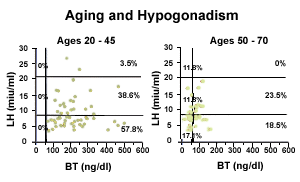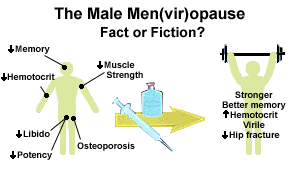In a younger person, below age 50, an emotional explanation, such as mild depression or family problems, would probably account for his complaints but, because he was well past 50 and had reported a decreased interest in sex, low testosterone syndrome was considered.[B]ecause he was well past 50 and had reported a decreased interest in sex, low testosterone syndrome was considered.
Here are Mr. B's answers to the St. Louis University Low Testosterone Syndrome Survey:
- Do you have a decrease in libido? Yes
- Do you have a lack of energy? Yes
- Do you have a decrease in strength and/or endurance? Yes
- Do you have a decreased enjoyment of life? No
- Are you sad? No
- Are you grumpy? Yes
- Are your erections less strong? Yes
- Have you noticed a recent deterioration in your ability to play sports? Yes
- Are you falling asleep earlier after dinner? No
- Has there been a recent deterioration in your work performance? No
If a male over 50 answers yes to the first or seventh questions or yes on any three other questions, low testosterone syndrome should be suspected.
The Low Testosterone Syndrome
As is shown in Figure 1, nearly half of healthy males over 50 years of age have testosterone levels less than those seen in normal young males.
Figure 1

Statistical studies have suggested the following effects may be associated with decline in testosterone:
- Decreased libido (enthusiasm for sex, sexual thoughts, etc.)
- Decreased muscle mass
- Decreased memory
- Increased heart disease
Treatment
Testosterone replacement is the standard treatment. Studies have shown increased strength, improved visual spatial thinking, increased bone and lean body mass and decreased levels of leptin (the fat hormone).
The major side effect of testosterone therapy is an increase in the percentage of red blood cells (the hematocrit) in the blood. People with too thick blood run the risk of blood clots and other mechanical blockages, especially in the smaller arteries and veins. When the hematocrit is more than 55%, testosterone needs to be discontinued or the patient has to have a blood letting. Hematocrit should be followed every three months. Other side effects include:
- gynecomastia (breast enlargement)
- water retention leading to hypertension or congestive heart failure
- possible accelerated growth of prostatic cancer
However, evidence from available studies suggests that testosterone does not worsen benign prostatic enlargement in older men and has no effect, one way or the other, on blood cholesterol levels.
Methods of Testosterone Administraton
Most often, testosterone is adminstered intramuscularly. Usually 200 mg of testosterone enanthate or cypionate is given every two weeks. Patients can be taught to self-inject at home.
Two testosterone patches are available. Testoderm® is placed on the shaved scrotum, while Androderm® is placed directly on the skin. Androderm® has a high rate of skin allergies and both patches are much more expensive than the injections.
In Canada and Europe, testosterone undecenoate (Organon®) is an oral preparation that is absorbed through the lymph channels, making it less damaging to the liver than other orally available forms of testosterone.
Finally, intramuscular implantation of testosterone pellets represents a depot delivery system.
Conclusion
The potential of testosterone therapy of the male meno(viro)pause is outlined in Figure 2:
Figure 2





